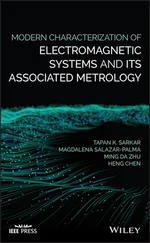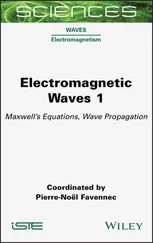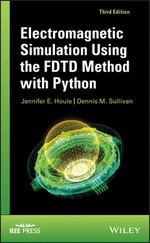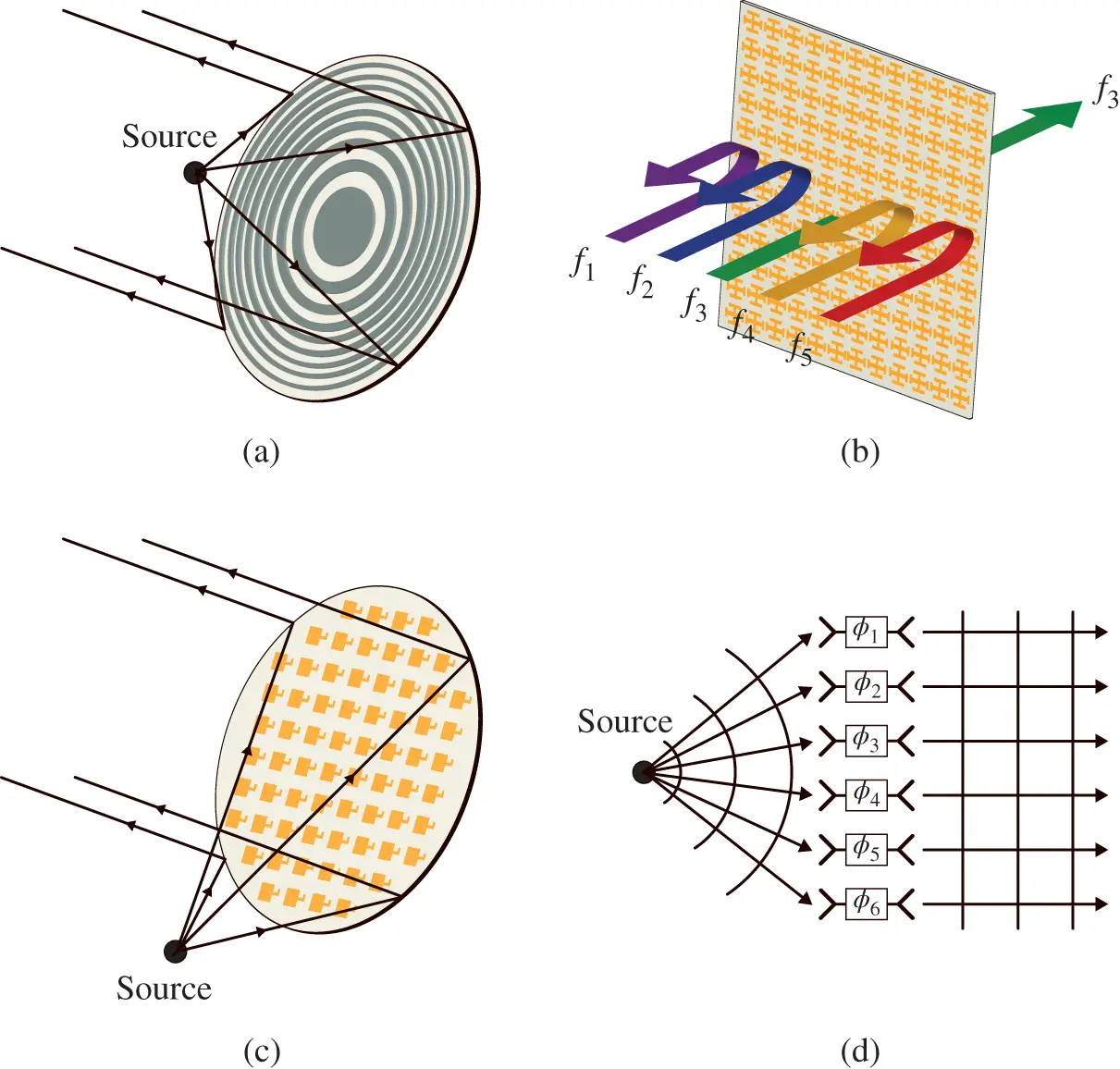
Figure 1.1 Examples of two-dimensional waves manipulating structures [2]. (a) Fresnel-zone plate reflector. (b) Reflectarray. (c) Interconnected-array lens. (d) Frequency-selective surface. Due to their structural configuration, (a) and (c) do not qualify as metasurfaces. On the other hand, the structures in (b) and (d) can be homogenized into effective material parameters and hence correspond to metasurfaces.
The structures and systems presented in Figure 1.1are the precursors of current metasurfaces. However, they are not the only ones. Indeed, there are many other examples of electrically thin structures that would be today considered as metasurfaces. For instance, consider the case of near-field plates [51, 65, 66] and impedance surfaces converting surface waves into space waves [43, 97], which, unlike the structures in Figure 1.1that are restricted to space-wave transformations, can accommodate both space waves and surface waves.
As of today, there are countless examples of metasurface concepts and applications that have been reported in the literature and it would therefore be impossible to provide a complete description of all of them. Instead, we shall now present a non-exhaustive list of some typical applications of metasurfaces. A very common application is that of polarization conversion [45, 60, 69, 90, 99, 157, 173, 180], where a linearly polarized wave may be transformed either into a circularly polarized one or be rotated using chirality [77]. Metasurfaces have also been commonly used to control the amplitude of the incident wave and, for instance, been used as perfect absorbers by altering the amplitude of the fields so that no reflection or transmission can occur [19, 40, 91, 135, 168, 172, 177]. Nevertheless, one of the most spectacular aspects of metasurfaces is their wavefront manipulating capabilities, which is typically based on the same physical concept used to realize Fresnel lenses [106] and blazed gratings [38, 112], and which have been used for applications such as generalized refraction, collimation, focalization, and holography [1, 12, 46, 47, 55, 62, 63, 95, 96, 136, 153, 154, 175, 178, 179, 181]. Finally, more exotic applications include, for instance, the generation of vortex beams characterized by orbital angular momentum [76, 93, 127, 161, 171, 176], stable tractor beams for nanoparticle manipulation [128], nonreciprocal scattering for electromagnetic isolation [33, 36, 137, 159], nonlinear interactions [89, 169, 182], analog computing [131, 156], and spatial filtering [117, 151, 152].
1 1 Defense Advanced Research Projects Agency.
2
Electromagnetic Properties of Materials
In order to effectively model, synthesize, and analyze a metasurface, we need to understand how it interacts with electromagnetic waves. From a general perspective, understanding the interactions of a given structure with an electromagnetic wave requires two fundamental prerequisites: (i) a description of the structure in terms of electromagnetic material parameters and (ii) the availability of appropriate boundary conditions. The purpose of this chapter is to address the first prerequisite, while the second one will be dealt with in Chapter 3.
The concepts discussed in this chapter are presented for the general perspective of volume materials, and hence deal with 3D material parameters. However, they also essentially apply to metasurfaces, which are modeled by 2D material parameters throughout the book, as will be established in Chapter 3.
This chapter presents a general description of the medium parameters and constitutive relations of materials. It also provides a detailed discussion of the physical properties that are inherently related to these parameters. Specifically, Section 2.1introduces the conventional bianisotropic constitutive relations. Section 2.2describes the temporal response of matter (temporal dispersion) and the mechanism responsible for resonances. It also provides the fundamental relationship between causality, and the real and imaginary parts of material parameters through the Kramers–Kronig relations. Section 2.3presents the spatially dispersive nature of matter (spatial dispersion), which helps understanding the fundamental origin of bianisotropy. Sections 2.4and 2.5derive the Lorentz reciprocity theorem and the Poynting theorem, respectively. Based on the Poynting theorem, Section 2.6then deduces energy conservation relations for lossless-gainless systems both in terms of susceptibilities and scattering parameters. Finally, Section 2.7classifies bianisotropic media according to their fundamental material properties.
2.1 Bianisotropic Constitutive Relations
The electromagnetic response of a linear medium may be expressed in the frequency domain, using the MKS system of units, as
( 2.1a) 
( 2.1b) 
where  (C/
(C/  ) and
) and  (Wb/
(Wb/  ) are, respectively, the electric displacement vector and the magnetic flux density vector, which depend on the applied electric field vector
) are, respectively, the electric displacement vector and the magnetic flux density vector, which depend on the applied electric field vector  (V/m) and on the magnetic field vector
(V/m) and on the magnetic field vector  (A/m) as well as on the material polarizations via the electric polarization density vector
(A/m) as well as on the material polarizations via the electric polarization density vector  (C/
(C/  ) and the magnetic polarization density vector
) and the magnetic polarization density vector  (A/m). The constants
(A/m). The constants  F/m and
F/m and  H/m are the vacuum permittivity and permeability, respectively.
H/m are the vacuum permittivity and permeability, respectively.
The polarization densities in ( 2.1) are typically expressed in terms of quantities which are either microscopic, the polarizabilities, or macroscopic, the susceptibilities. Although both the microscopic and macroscopic descriptions are applicable for modeling metasurfaces, we will mostly use the macroscopic model throughout the book, because it more conveniently describes metasurfaces as homogeneous media. For a bianisotropic metasurface, the polarization densities in ( 2.1) read
Читать дальше
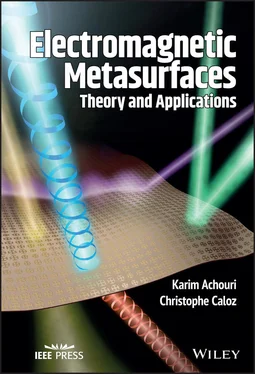



 (C/
(C/  ) and
) and  (Wb/
(Wb/  ) are, respectively, the electric displacement vector and the magnetic flux density vector, which depend on the applied electric field vector
) are, respectively, the electric displacement vector and the magnetic flux density vector, which depend on the applied electric field vector  (V/m) and on the magnetic field vector
(V/m) and on the magnetic field vector  (A/m) as well as on the material polarizations via the electric polarization density vector
(A/m) as well as on the material polarizations via the electric polarization density vector  (C/
(C/  ) and the magnetic polarization density vector
) and the magnetic polarization density vector  (A/m). The constants
(A/m). The constants  F/m and
F/m and  H/m are the vacuum permittivity and permeability, respectively.
H/m are the vacuum permittivity and permeability, respectively.






